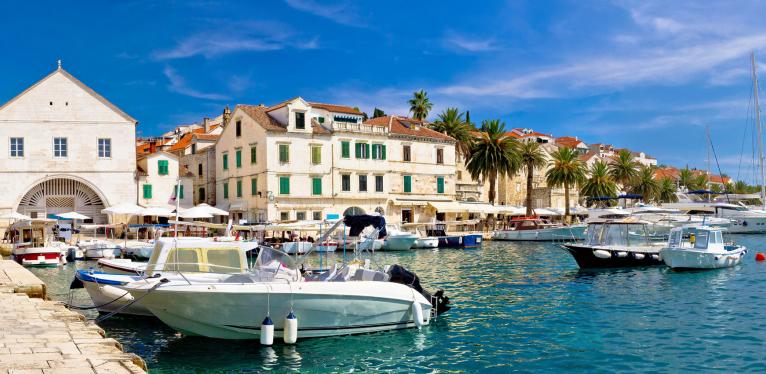

1. ST. STEPHEN'S CATHEDRAL - CITY HVAR
The square of St. Stephen locally known as the Pjaca is the largest main square in Dalmatia. It is bordered on the east side by the cathedral and bishop’s palace, on the west by Mandrač (a small port for boats) and to the northwest by the Leroj (clocktower) and the Loggia, which today form part of Hotel Palace Elisabeth. The cathedral was completed in the 18th century, when it acquired its present appearance. The cathedral has many valuable works of art, altar paintings and altars in different colored marbles.
More information: concierge@suncanihvar.com
2. ARSENAL THEATRE - CITY HVAR
The Arsenal Theatre is one of the oldest public theatres in Europe and belongs to the highest category of protected monuments. The building dates from the 13th century but was completely renovated and completed in 1612 when it took its present form. Today, it is one of the most imposing structures in the town. The theater is located on the first floor of the Arsenal which celebrated its 400th anniversary in 2012. It owes its existence to the then Prince of Hvar Pietro Semitecolo who was inspired by Italian theatre. Priorly, it was used as a maintenance and storage building by the Venetian navy, which overwintered in Hvar harbor.
More information: concierge@suncanihvar.com
3. SPANISH FORTRESS - CITY HVAR
Towering way above the city of Hvar is the famous Spanish Fortress (Španjola), built in the early 16th century during the Venetian rule. It is one of the most popular tourist attractions in Hvar, offering spectacular views of the town and the archipelago below. The fortress can easily be accessed by car or by foot directly from the city center.
More information: concierge@suncanihvar.com
4. FRANCISCAN MONASTERY - CITY HVAR
Walking along the promenade, past the Riva, yacht harbour hotel and the catamaran dock, the Franciscan Monastery comes into view. Built in 1465, it was jointly financed by the nobles of Hvar and sea commanders as a testament to the gratitude for many lives saved at sea. The local contribution included 1000 gold coins from Antun Lučić and his son Hanibal Lučić the famous poet which is buried under the main altar. Worth to visit also for the “Last Supper” painting by Palma the Younger which was given by the church during the Venetian rule.
More information: concierge@suncanihvar.com
5. HEKTOROVIĆ CASTLE - CITY STARI GRAD
The poet Petar Hektorović and his age are brought back to life in the Hektorović Castle, located in Stari Grad. In fact, it is a fortified Renaissance villa, with some characteristics of a monastery. The character of the man who created is reflected in its romantic park and fishpond and the stone inscriptions in which he explained certain aspects of his building venture and religious contemplations.
More information: concierge@suncanihvar.com
6. STARI GRAD PLAIN (HORA/AGER PHARIENSIS)
The most unusual testimony to the past which you will see in Stari Grad, leading towards the towns of Vrboska and Jelsa is the Stari Grad Plain. It was first colonized by the Greeks in the 4th century BC and remains practically intact since then. It was one of the first forms of parcelization and it is enlisted as a UNESCO World Heritage site. The landscape features ancient stone walls and trims, as well as small stone shelters bearing testimony to the ancient geometrical system of land division.
More information: concierge@suncanihvar.com
7. THE FORTRESS CHURCH - CITY VRBOSKA
The church of St. Mary, which stands like a tall stone ship above the town, dominates Vrboska. Originally, it was quite small, but after two great Turkish invasions when Hvar, Stari Grad and Vrboska were destroyed it was transformed into a strong fortress. It is worth climbing up the roof, where you can see how fortifications were organized. There is also a wonderful view of the town and the bay.
More informations: concierge@suncanihvar.com
8. ST. LAWRENCE CHURCH - CITY VRBOSKA
Some of the most valuable works of art, such as those by Paolo Veronese from the 16th century is kept in the St. Lawrence parish church. Many used to be stored in St. Mary’s (The Fortress Church) but were moved due to due to high relative humidity of the air in its interior, which does not provide appropriate conditions for keeping art.
More information: concierge@suncanihvar.com
9. ST. JOHN CHURCH - CITY JELSA
In the southwest extension of the modest square in Jelsa you can find a hidden gem. The Renaissance-Baroque square is worthy of admiration, but the octagonal Church of St. John is particularly notable, with its different stylistic features from the Gothic, Renaissance and Baroque periods.
More information: concierge@suncanihvar.com